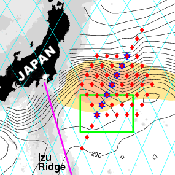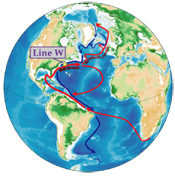|
|  |
 |
| |
Projects |
|
 |
Kuroshio Extension
System Study (KESS)
Kuroshio Extension System Study (KESS) is a collaborative
effort between the Woods Hole Oceanographic Institution,
the University of Rhode Island, and the University of
Hawaii. The purpose of KESS is to understand the processes
that govern the variability of and the interaction between
the Kuroshio Extension and its recirculation gyre. To
do this it will employ a large array of in-situ measurements
from combination pressure gauge and inverted echo sounders,
current meter moorings, and profiling floats, together
with satellite altimeter and sea surface temperature data.
[website] |
 |
ULTRAMOOR
The prototype ULTRAMOOR design is a subsurface mooring
that supports 10 (or more) discrete acoustic current meters.
Each current sensor is equipped with a small, low power
acoustic transmitter that transfers compressed data from
its instrument to a receiver located below the euphotic
zone (nominally at 500-m depth). The initial long-term
test of the ULTRAMOOR prototype was begun on November
20, 2001 offshore Bermuda. Retrieval of the system is
scheduled for November 2004. [website] |
 |
Line W
Located on the continental slope south of New England (near 40ºN, 70ºW) Line W is one component of a long-term climate observing system that is positioned to quantify variability in the deep limb of the Atlantic meridional overturning circulation (MOC). Combining an array of moored instruments with shipboard observations, Line W is designed to directly measure the time dependence of volume transport, advection of property anomalies, and propagation of topographic Rossby waves and boundary waves in the equatorward flowing deep western boundary current (DWBC). These measurements are key to clarifying the deep ocean response to variability in high-latitude air-sea exchanges and, ultimately, the ocean's role in global climate variability through changes in its transport of heat and freshwater. [website] |
| |
|
|
|
|
|

